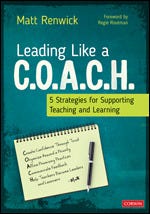How I Am Present During Literacy Instruction
Curiosity > Certainty
The kindergarten classroom resembled many visited before.
A shelf displayed picture books around the theme for the month.
Students’ names were placed underneath descriptions of learning centers.
A poem on poster paper was displayed on the front board, held up by magnets.
If I had assumed that these resources were typical, I may never have learned about the teacher’s innovative use of the poem.
At the end of my instructional walk, noting strengths of the teacher’s instruction, I asked her why a few of the words were highlighted in the poem.
Here is what she explained:
“On Monday, a new poem is introduced. The first day, we read it aloud together, multiple times. The second day, we read it together again, this time highlighting our sight words that are currently posted on our word wall. The third, fourth and fifth days, we point out different sound patterns to develop phonemic awareness.”
I may never have learned about her authentic approach to foundational reading skills if I had led with judgment instead of curiosity.
The Myth of Certainty
“Understanding comes through awareness. Can we, then, approach our experience - our sensations, feelings, and thoughts - quite simply, as if we had never known them before, and, without prejudice, look at what is going on?”
- Alan Watts, The Wisdom of Insecurity: A Message for an Age of Anxiety
I’ve been trained in two educator evaluation systems. While each differs in the language of the rubric and steps to follow for observations, what they have in common is collecting a “preponderance of evidence” to be certain about our assessment of teachers’ performance. That seems fair, right?
The problem is, there is little way in conversation between teacher and supervisor during the observation. I am documenting what teachers are saying, what students are doing, and aspects of the environments and instructional resources. If I am not talking to the teacher about their work, then I cannot fully understand their intent for inclusion nor their perception on how it impacts learning.
As leaders, we fool ourselves into believing our “objectivity” ensures a fair evaluation process. I come with preconceived notions about classroom instruction. So do you. A rubric doesn’t change that, no matter how specific the language.
For example: A poem on a wall is an anchor chart. That is, until I become curious and discover it is a powerful tool for rereading, teaching foundational reading skills, and building joy and success through the written word. My mind has expanded, not because of a rubric, but because I was willing to put it down and just ask and listen.
Try This: No Notes, Just Presence
“You may ask, ‘Which experiences, which sensations and feelings, shall we look at?’ I will answer, ‘Which ones can you look at?’ The answer is that you must look at the ones you have now.”
- Alan Watts, The Wisdom of Insecurity: A Message for an Age of Anxiety
This month, visit classrooms with no agenda. Bring along your instructional framework for some guidance but keep the laptop and the notepad in your office.
Then visit classrooms. You may use the following questions to guide your experience.
How are students supported with resources, structures, and time to learn?
How is the classroom laid out to optimize whole group, small group, and independent learning?
What about the classroom library makes it inviting for students to explore and to find that next book to read?
What strengths are visible in the student work on display?
How do the topics of study engage students in relevant study and inquiry?
If you were a student in this classroom, where would you gravitate toward? Why?
Important: This is not a checklist. You aren’t “looking for” these items to be present or not in the classroom. These questions are meant to help you be more present.
What is not visible, ignore. What is, let the students and teacher know what you noticed, framed as a strength, and then ask for their thoughts on it. For example:
“I noticed that reading and rereading the poem together gave you authentic opportunities for learning reading skills. How do you feel it is going?”
Even this statement contains traces of judgment. But at least I am presuming positive intentions.
Then let the teacher or the students talk and simply affirm their responses. Operate more like a researcher than a supervisor. You are taking a stance toward curiosity instead of a desire for certainty. The results are neutral; judgment is withheld.
Our world remains full of uncertainty. It drives some people to try and gain control, to feel certain about the outcomes. But that positions us in the future.
When our teachers ask us to be visible, what they mean is they want us to be present. Not to judge but to notice. Not to have all the answers, but to explore their questions with them.
When you think about it like this, it feels very freeing.
These ideas are explored further in my upcoming book. See below for more information.


